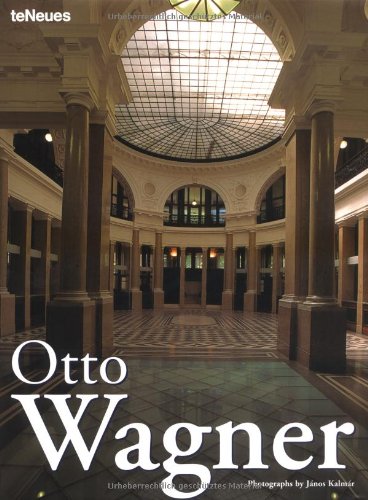Asensio Paco Kliczkowski Sol Bain (1 results)
Product Type
- All Product Types
- Books (1)
- Magazines & Periodicals
- Comics
- Sheet Music
- Art, Prints & Posters
- Photographs
- Maps
-
Manuscripts &
Paper Collectibles
Condition
- All Conditions
- New
- Used
Binding
- All Bindings
- Hardcover
- Softcover
Collectible Attributes
- First Edition
- Signed
- Dust Jacket
- Seller-Supplied Images
- Not Printed On Demand
Seller Location
Seller Rating
-
Otto Wagner
Published by TeNeues, Dusseldorf, 2002
ISBN 10: 382385545XISBN 13: 9783823855453
Seller: Ground Zero Books, Ltd., Silver Spring, MD, U.S.A.
Book First Edition
Hardcover. Condition: Very good. Dust Jacket Condition: Very good. Janos Kalmar (Photographer) (illustrator). Presumed First Edition, First printing. The format is approximately 6.75 inches by 9 inches. 80 pages. Illustrations (most in color). Text is in English, French, Italian, and German. Contents include Landerbank, Wagner's Villas, Majolica House, The Linke Wienzeile Building 38, Vienna Metro Stations, Hofpavillon, Karlsplatz, Steinhof Church, Postparkasse of Austria, Residence at Neustiftgasse 40, and Chronology. This is one of a new series about the master of classical architecture. Each volume in this eminently attractive series highlights the work of renowned architect of the past centuries. Packed with dazzling photographs of exteriors sand interiors, detailed plans and brief, comprehensive texts. Otto Koloman Wagner (13 July 1841 - 11 April 1918) was an Austrian architect, furniture designer and urban planner. He was a leading member of the Vienna Secession movement of architecture, founded in 1897, and the broader Art Nouveau movement. Many of his works are found in his native city of Vienna, and illustrate the rapid evolution of architecture during the period. His early works were inspired by classical architecture. By mid-1890s, he had already designed several buildings in what became known as the Vienna Secession style. Beginning in 1898, with his designs of Vienna Metro stations, his style became floral and Art Nouveau, with decoration by Koloman Moser. His later works, 1906 until his death in 1918, had geometric forms and minimal ornament, clearly expressing their function. They are considered predecessors to modern architecture. Otto Wagner (Penzing near Vienna 1841-died Vienna, 1918) studied in both Berlin and Vienna. He was put in charge of the general plan for Vienna, under the authority of the City Hall's Higher Committee for Construction. The principal objective was to set up a railway system and to control the Danube River. He was the mentor of Josef Hoffman and Josef Maria Olbrich. At the end of the century, during the Secession of Vienna, he worked on a number of projects, including houses for Linke Wienzeile, the Zeit telegraph office and the Postal Savings Bank (Postsparkassenamt). He was also the designer of the Steinhof Church and the second Wagner villa, among other buildings.


